308 scholarly books by CSLI and 12
have author last names that start with D
308 scholarly books by CSLI and 12
308 scholarly books by CSLI
12 have author last names that start with D have author last names that start with D
12 have author last names that start with D have author last names that start with D
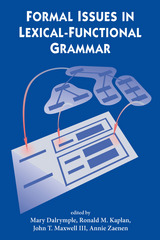
Formal Issues in Lexical-Functional Grammar
Mary Dalrymple
CSLI, 1994
Lexical-Functional Grammar was first developed by Joan Bresnan and Ronald M. Kaplan in the late 1970s, and was designed to serve as a medium for expressing and explaining important generalisations about the syntax of human languages and thus to serve as a vehicle for independent linguistic research. An equally important goal was to provide a restricted, mathematically tractable notation that could be interpreted by psychologically plausible and computationally efficient processing mechanisms. The formal architecture of LFG provides a simple set of devices for describing the common properties of all human languages and the particular properties of individual languages. This volume presents work conducted over the past several years at the Xerox Palo Alto Research Center, Stanford University, and elsewhere. The different sections link mathematical and computational issues and the analysis of particular linguistic phenomena in areas such as wh-constructions, anaphoric binding, word order and coordination.
[more]

Language and the Creative Mind
Barbara Dancygier
CSLI, 2013
This volume brings together papers from the 11th Conceptual Structure, Discourse and Language Conference, held in Vancouver in May 2012. In the last few years, the cognitive study of language has begun to examine the interaction between language and other embodied communicative modalities, such as gesture, while at the same time expanding the traditional limits of linguistic and cognitive enquiry into creative domains such as music, literature, and visual images. Papers in this collection show how the study of language paves the way for these new areas of investigation. They bring issues of multimodal communication to the attention of linguists, while also looking through and beyond language into various domains of human creativity. This refreshed view of the relations across various communicative domains will be important not only to linguists, but also to all those interested in the creative potential of the human mind.
[more]

Online Deliberation
Design, Research, and Practice
Todd Davies
CSLI, 2009
Can new technology enhance local, national, and global democracy? Online Deliberation is the first book that attempts to sample the full range of work on online deliberation, forging new connections between academic research, web designers, and practitioners.
Since the most exciting innovations in deliberation have occurred outside of traditional institutions, and those involved have often worked in relative isolation from each other, research conducted on this growing field has to this point neglected the full perspective of online participation. This volume, an essential read for those working at the crossroads of computer and social science, illuminates the collaborative world of deliberation by examining diverse clusters of Internet communities.
[more]
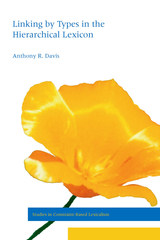
Linking by Types in the Hierarchical Lexicon
Anthony R. Davis
CSLI, 2001
Actions are described by verbs whose subjects, objects, and other complements refer to various participants in those actions. What linguistic principles determine which participants are referred to by each component of a verb?
Many previous approaches to this problem have employed a set of thematic roles, such as agent and patient, to classify varieties of participants. The alternative developed here fits within the framework of Head-Driven Phrase Structure Grammar while utilizing typed feature structures, certain basic features of verb meaning, a hierarchical classification of verb meanings, and constraints from more general to more specific word classes. Relying on no special mechanisms or components of grammar, this book is unique in its ability to account for the observed range of verb types in human languages with a simple yet widely applicable set of principles.
Many previous approaches to this problem have employed a set of thematic roles, such as agent and patient, to classify varieties of participants. The alternative developed here fits within the framework of Head-Driven Phrase Structure Grammar while utilizing typed feature structures, certain basic features of verb meaning, a hierarchical classification of verb meanings, and constraints from more general to more specific word classes. Relying on no special mechanisms or components of grammar, this book is unique in its ability to account for the observed range of verb types in human languages with a simple yet widely applicable set of principles.
[more]
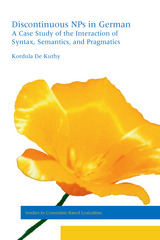
Discontinuous NPs in German
A Case Study of the Interaction of Syntax, Semantics, and Pragmatics
Kordula De Kuthy
CSLI, 2002
This book investigates the occurrence of discontinuous noun phrases, arguing that many of the factors that previous literature has tried to explain in terms of syntactic restrictions on movements are in fact derivable from discourse factors. De Kuthy’s HPSG and information-structure analyses provide an exemplary argument for rethinking the division of labor between syntax and a theory of discourse.
[more]
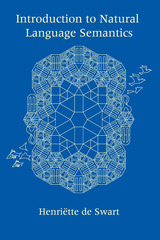
Introduction to Natural Language Semantics
Henriette de Swart
CSLI, 1998
Semantics is defined as the study of meaning expressed by elements of a language or combinations thereof. Utterances are not just noises or scribbles, they are used to convey information, and they are linked with kinds of events and with states of mind.
This text examines what issues semantics, as a theory of meaning, should address; determining what the meanings of words of the language are and how to semantically combine elements of a language to build up complex meanings. Logical languages are then developed as formal metalanguages to natural language. Subsequent chapters address propositional logic, the syntax and semantics of (first-order) predicate logic as an extension of propositional logic, and Generalized Quantifier theory. Going beyond extensional theory, Henri'tte de Swart relativizes the interpretation of expressions to times to account for verbal tense, time adverbials and temporal connectives and introduces possible worlds to model intensions, modal adverbs and modal auxiliaries.
This broad overview of natural language semantics should cover most of the points addressed in an introductory course. Numerous exercises punctuate each chapter and an example exam based on the materials presented is included, making this volume a perfect textbook and resource for any undergraduate or graduate-level introductory course in semantics.
This text examines what issues semantics, as a theory of meaning, should address; determining what the meanings of words of the language are and how to semantically combine elements of a language to build up complex meanings. Logical languages are then developed as formal metalanguages to natural language. Subsequent chapters address propositional logic, the syntax and semantics of (first-order) predicate logic as an extension of propositional logic, and Generalized Quantifier theory. Going beyond extensional theory, Henri'tte de Swart relativizes the interpretation of expressions to times to account for verbal tense, time adverbials and temporal connectives and introduces possible worlds to model intensions, modal adverbs and modal auxiliaries.
This broad overview of natural language semantics should cover most of the points addressed in an introductory course. Numerous exercises punctuate each chapter and an example exam based on the materials presented is included, making this volume a perfect textbook and resource for any undergraduate or graduate-level introductory course in semantics.
[more]
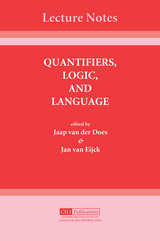
Quantifiers, Logic, and Language
Van der Does
CSLI, 1996
Subject: Linguistics; Grammar--Quantifiers
[more]

Language at Work
Analyzing Communication Breakdown in the Workplace to Inform Systems Design
Keith Devlin
CSLI, 1996
People are very creative in their use of language. This observation was made convincingly by Chomsky in the 1950s and is generally accepted in the scientific communities concerned with the study of language. Computers, on the other hand, are neither creative, flexible, nor adaptable. This is in spite of the fact that their ability to process language is based largely on the grammars developed by linguists and computer scientists. Thus, there is a mismatch between the observed human creativity and our ability as theorists to explain it. Language at Work examines grammars and other descriptions of language by combining the scientific and the practical. The scientific motivation is to unite distinct intellectual traditions, mathematics and descriptive social science, which have tried to provide an adequate explanation of language and its use on their own to no avail. This volume argues that Situation Theory, a theory of information couched in mathematics, has provided a uniform framework for the investigation of the creative aspects of language use. The application of Situation Theory in the study of language use in everyday communication to improve human/computer interaction is explored and espoused.
[more]
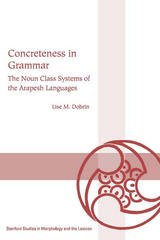
Concreteness in Grammar
Lise Dobrin
CSLI, 2013
Based on an exhaustive search of published sources and the author’s firsthand fieldwork, Concreteness in Grammar explores the role of phonological form in the noun class systems of the Arapesh languages spoken in Papua New Guinea. Linguists have long known that formal critical play a role alongside semantics in the classification of lexical terms. In Arapesh, virtually every possible final ending of a noun is represented in the paradigm of noun class and agreement markers, reflecting an interpenetraion of sound structure and grammar that many theories would disallow as wildly unconstrained. In this book, Lise Dobrin describes these formal patterns in order to reveal their naturalness and elegance, establishing their place in a typology of noun class systems and drawing out their significance for theories of grammatical architecture.
A rigorous study of an endangered language, Concreteness in Grammar revisits the definition of a morpheme and looks at unusual language patterns to reveal the naturalness of grammar.
[more]
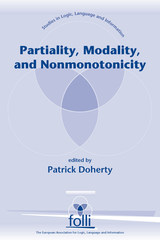
Partiality, Modality and Nonmonotonicity
Patrick Doherty
CSLI, 1996
This edited volume of articles provides a state-of-the-art description of research in logic-based approaches to knowledge representation which combines approaches to reasoning with incomplete information that include partial, modal, and nonmonotonic logics. The collection contains two parts: foundations and case studies. The foundations section provides a general overview of partiality, multi-valued logics, use of modal logic to model partiality and resource-limited inference, and an integration of partial and modal logics. The case studies section provides specific studies of issues raised in the foundations section. Several of the case studies integrate modal and partial modal logics with nonmonotonic logics. Both theoretical and practical aspects of such integration are considered. Knowledge representation issues such as default reasoning, theories of action and change, reason maintenance, awareness, and automation of nonmonotonic reasoning are covered.
[more]

Knowledge and the Flow of Information
Fred I. Dretske
CSLI, 1999
An attempt to develop a theory of knowledge and philosophy of mind using ideas derived from the mathematical theory of communication developed by Claude Shannon. Information is seen as an objective commodity defined by the dependency relations between distinct events. Knowledge is then analyzed as information caused belief. Perception is the delivery of information caused belief. Perception is the delivery of information in analog form (experience) for conceptual utilization by cognitive mechanisms. The final chapters attempt to develop a theory of meaning (or belief content) by viewing meaning as a certain kind of information-carrying role.
[more]
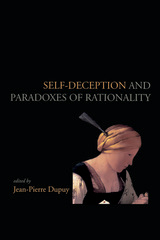
Self-Deception and Paradoxes of Rationality
Jean-Pierre Dupuy
CSLI, 1998
Self-deception is one of the topics that lends itself best to the task of exploring the possibilities of cross-fertilization between 'continental philosophy' and 'analytic philosophy'. Fifty years ago, in Being and Nothingness, Sartre defined the core notion of 'Bad Faith' as lying to oneself. On the other side of the Atlantic, self-deception has become one of the most exciting puzzles in the philosophy of mind, and a number of paradoxes encountered by the theory of rational choice involve that very same notion. One of the objectives is to show that bridges can be thrown over the gap between the two traditions, but also that both of them make self-deception too intrapsychic and suffer from a serious individualistic bias. The conference was intended to explore the intersubjective and social dimensions of self-deception.
[more]
READERS
Browse our collection.
PUBLISHERS
See BiblioVault's publisher services.
STUDENT SERVICES
Files for college accessibility offices.
UChicago Accessibility Resources
home | accessibility | search | about | contact us
BiblioVault ® 2001 - 2024
The University of Chicago Press









